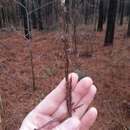Comprehensive Description
provided by North American Flora
Erianthus contortus Ell. Bot. S. C. & Ga. 1 : 40. 1816
Erianthus alopecuroides contortus Vasey, Grasses U, S. 17. 1883. Erianthus saccharoides contortus Hack, in DC. Monog. Phan. 6 : 132. 1889. Eria?ilhus Smallii Nash, Bull. N. Y. Bot. Gard. 1 : 429. 1900.
Stems 1-2.5 m. tall, the nodes often pubescent with readily deciduous hairs, the summit and panicle-axis glabrous or appressedpubescent ; leaf -sheaths smooth or rough, sometimes hirsute at the apex; blades 1.5-8 dm. long, 5-20 mm. wide, smooth or rough; panicle 1.5-4 dm. long, 3-6 cm. wide, its branches erect, the larger 4-10 cm. long; spikelets crowded, equaling but not exceeding the basal hairs and about one half as long again as the internodes ; outer 2 scales 7-9 mm. long, pilose with long hairs, the fourth scale 2-cleft at the apex, the teeth long and subulate, the awn 1.5-2.5 cm. long, the included portion spiral at the base, the remainder loosely spiral.
Type locality : Savannah, Georgia.
Distribution : Delaware (?) and Maryland to Florida and Texas.
- bibliographic citation
- Percy Wilson, Per Axel Rydberg, Norman Taylor, Nathaniel Lord Britton, John Kunkel Small, George Valentine Nash. 1909. PANDANALES-POALES; TYPHACEAE, SPARGANACEAE, ELODEACEAE, HYDROCHARITACEAE, ZANNICHELLIACEAE, ZOSTERACEAE, CYMODOCEACEAE, NAIADACEAE, LILAEACEAE, SCHEUCHZERIACEAE, ALISMACEAE, BUTOMACEAE, POACEAE (pars). North American flora. vol 17(1). New York Botanical Garden, New York, NY
Physical Description
provided by USDA PLANTS text
Perennials, Terrestrial, not aquatic, Rhizomes present, Rhizome short and compact, stems close, Stems nodes swollen or brittle, Stems erect or ascending, Stems caespitose, tufted, or clustered, Stems terete, round in cross section, or polygonal, Stem nodes bearded or hairy, Stem internodes solid or spongy, Stems with inflorescence 1-2 m tall, Stems with inflorescence 2-6 m tall, Stems, culms, or scapes exceeding basal leaves, Leaves mostly cauline, Leaves conspicuously 2-ranked, distichous, Leaves sheathing at base, Leaf sheath mostly open, or loose, Leaf sheath smooth, glabrous, Leaf sheath hairy, hispid or prickly, Leaf sheath hairy at summit, throat, or collar, Leaf sheath and b lade differentiated, Leaf blades linear, Leaf blades 1-2 cm wide, Leaf blades mostly flat, Leaf blades mostly glabrous, Leaf blades scabrous, roughened, or wrinkled, Ligule present, Ligule a fringed, ciliate, or lobed membrane, Inflorescence terminal, Inflorescence a contracted panicle, narrowly paniculate, branches appressed or ascending, Inflorescence solitary, with 1 spike, fascicle, glomerule, head, or cluster per stem or culm, Inflorescence branches more than 10 to numerous, Flowers bisexual, Spikelets pedicellate, Spikelets sessile or subsessile, Spikelets dorsally compressed or terete, Spikelet less than 3 mm wide, Spikelets with 1 fertile floret, Spikelets with 2 florets, Spikelets paired at rachis nodes, Spikelets all alike and fertille, Spikelets in paired units, 1 sessile, 1 pedicellate, Spikelets bisexual, Inflorescence disarticulating between nodes or joints of rachis, rachis fragmenting, Spikelets disarticulating below the glumes, Spikelets falling with parts of disarticulating rachis or pedicel, Inflorescence branches deciduous, falling intact, Spikelets conspicuously hairy , Rachilla or pedicel hairy, Glumes present, empty bracts, Glumes 2 clearly present, Glumes equal or subequal, Glumes equal to or longer than adjacent lemma, Glumes 1 nerved, Lemmas thin, chartaceous, hyaline, cartilaginous, or membranous, Lemma 1 nerved, Lemma apex acute or acuminate, Lemma apex dentate, 2-fid, Lemma distinctly awned, more than 2-3 mm, Lemma with 1 awn, Lemma awn 1-2 cm long, Lemma awn 2-4 cm long or longer, Lemma awned from tip, Lemma awn twisted, spirally coiled at base, like a corkscrew, Lemma awn once geniculate, bent once, Lemma margins thin, lying flat, Lemma straight, Callus or base of lemma evidently hairy, Callus hairs shorter than lemma, Callus hairs equal to lemma, Stamens 2, Styles 2-fid, deeply 2-branched, Stigmas 2, Fruit - caryopsis.

